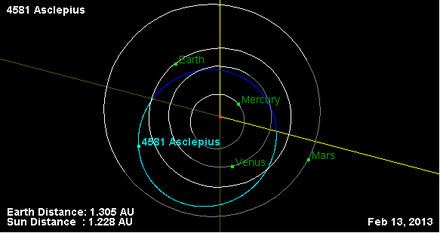Discovery date 31 March 1989 Aphelion 1.3875 AU (207.57 Gm) Orbits Sun | Alternative names 1989 FC Observation arc 9628 days (26.36 yr) Discovered 31 March 1989 Asteroid group Apollo asteroid | |
 | ||
Discovered by Henry E. HoltNorman G. Thomas Discoverers Henry E. Holt, Norman G. Thomas Similar 69230 Hermes, Sun, 4183 Cuno, 4660 Nereus, 4769 Castalia | ||
4581 Asclepius (/əˈskliːpiəs/ ə-SKLEE-pee-əs) is a small asteroid of the Apollo group that makes close orbital passes with Earth. Discovered in 1989 by American astronomers Henry E. Holt (1929-) and Norman G. Thomas (1930-), Asclepius is named after the Greek demigod of medicine and healing.
Asclepius passed by Earth on March 22, 1989, at a distance of 0.00457 AU (684,000 km; 425,000 mi). Although this exceeds the Moon's orbital radius, the close pass received attention at that time, especially since the asteroid passed through the exact position of Earth only six hours earlier. "On the cosmic scale of things, that was a close call," said Dr. Henry Holt. Geophysicists estimate that collision with Asclepius would release energy comparable to the explosion of a 600 megaton atomic bomb. The asteroid was discovered March 31, 1989, nine days after its closest approach to the Earth.
Subsequent discoveries revealed that a whole class of such objects exists. Close approaches by objects the size of Asclepius pass by every two or three years, undetected until the start of computerized near-Earth object searches.
On 24 March 2051, the asteroid will pass 0.0123 AU (1,840,000 km; 1,140,000 mi) from the Earth. It will be the eighth pass of less than 30 Gm in this century. JPL shows that the uncertainty region of the asteroid will cause it to mostly likely pass from 0.02 AU to 0.17 AU from the Earth in 2135.
